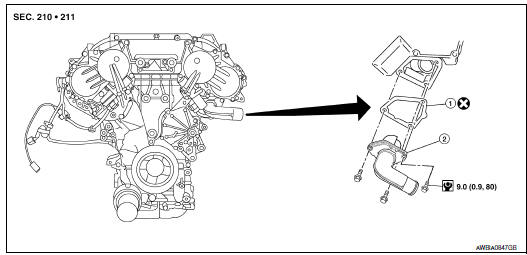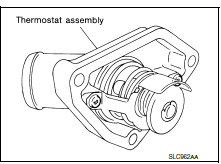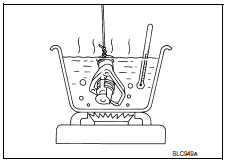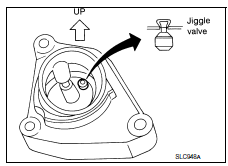Nissan Maxima Service and Repair Manual: Thermostat and thermostat housing
Removal and Installation

- Gasket
- Thermostat assembly (water inlet)
WARNING: Do not remove the radiator cap when the engine is hot. Serious burns could occur from high pressure engine coolant escaping from the radiator. Wrap a thick cloth around the radiator cap. Slowly turn it a quarter of a turn to release built-up pressure. Carefully remove radiator cap by turning it all the way.
CAUTION: Perform when engine is cool.
NOTE: When removing components such as hoses, tubes/lines, etc., cap or plug openings to prevent fluid from spilling.
REMOVAL

- Drain coolant from radiator. Refer to CO-11, "Changing Engine Coolant".
- Disconnect reservoir hose and remove reservoir tank.
- Disconnect the harness connector from the VTC solenoid (LH).
- Disconnect lower radiator hose from thermostat assembly.
- Remove thermostat assembly (water inlet).
CAUTION: Do not disassemble thermostat assembly (water inlet).
Replace them as a unit, if necessary.
INSPECTION AFTER REMOVAL

- Place a thread so that it is caught in the valves of the thermostat.
Immerse fully in a container filled with water. Heat while stirring.
- The valve opening temperature is the temperature at which the valve opens and the thermostat falls from the thread.
- Continue heating. Check the full-open lift amount. NOTE: The full-open lift amount standard temperature for the thermostat is the reference value.
- After checking the full-open lift amount, lower the water temperature and check the valve closing temperature.

- If valve seating at measured values are out of standard range, replace water inlet and thermostat assembly.
INSTALLATION
Installation is in the reverse order of removal.

- Install thermostat with jiggle valve facing upward.
- After installation refill engine coolant and check for leaks. Refer to CO-11, "Changing Engine Coolant" and CO-10, "System Inspection".
CAUTION: Do not spill coolant in engine compartment. Use a shop cloth to absorb coolant.
 Water pump
Water pump
Exploded View
Water pump
O-rings
Timing chain tensioner
Intake valve timing control solenoid
valve cover (RH) (bank 1)
Water pump cover
Removal and Installation
WARNING:
Do no ...
 Water outlet and water piping
Water outlet and water piping
Removal and Installation
Heater hose
Clamp
Water hose
Clamp
Water outlet
Gasket
Gasket
Water connector
O-ring
Water bypass pipe
Clamp
Water hose
Heater pipe
...
Other materials:
Diagnosis and repair workflow
Repair Work Flow
WORK FLOW
DETAILED FLOW
1.CUSTOMER INFORMATION
Interview the customer to obtain detailed information about the symptom.
2.PRELIMINARY CHECK
Perform preliminary check
3.SELF-DIAGNOSIS
Perform SELF-DIAGNOSIS.
4.SYMPTOM
Check for symptoms.
5.MALFUNCTIONING PARTS
Repair or ...
Cleaning interior
Occasionally remove loose dust from the interior
trim, plastic parts and seats using a vacuum
cleaner or soft bristled brush. Wipe the vinyl and
leather (if so equipped) surfaces with a clean,
soft cloth dampened in mild soap solution, then
wipe clean with a dry, soft cloth.
Regular care and ...
B2604 transmission range switch
Description
BCM confirms the shift position with the following 4
signals.
CVT selector lever
Transmission range switch
P position signal from IPDM E/R (CAN)
P position signal from TCM (CAN)
DTC Logic
DTC DETECTION LOGIC
NOTE:
I ...
Nissan Maxima Owners Manual
- Illustrated table of contents
- Safety-Seats, seat belts and supplemental restraint system
- Instruments and controls
- Pre-driving checks and adjustments
- Monitor, climate, audio, phone and voice recognition systems
- Starting and driving
- In case of emergency
- Appearance and care
- Do-it-yourself
- Maintenance and schedules
- Technical and consumer information
Nissan Maxima Service and Repair Manual
0.0076
